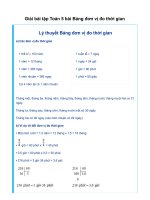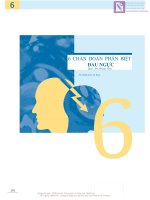Pediatric emergency medicine trisk 130
Bạn đang xem bản rút gọn của tài liệu. Xem và tải ngay bản đầy đủ của tài liệu tại đây (139.51 KB, 4 trang )
Bartter syndrome
Sodium-losing
Congenital adrenal hypoplasia
Diuretics
Sodium-losing nephropathy
Pseudohypoaldosteronism
Gastrointestinal losses
Gastroenteritis a
Diarrhea (see Chapter 23 Diarrhea )
Secretory vs. nonsecretory
Vomiting (see Chapter 81 Vomiting )
Obstructive vs. nonobstructive
Translocation of fluids
Burns
Ascites (e.g., nephrotic syndrome)
Intraintestinal
Paralytic ileus
Postabdominal surgery
a Indicates
common cause of dehydration in pediatrics.
TABLE 22.2
SYMPTOMS ASSOCIATED WITH DEHYDRATION
Signs and
symptoms
Minimal or no
dehydration
(<3% loss of body
weight)
Mild to moderate
dehydration (3–
9% loss of body
weight)
Severe
dehydration
(>9% loss of
body weight)
Mental status
Well; alert
Thirst
Apathetic,
lethargic,
unconscious
Drinks poorly;
unable to drink
Heart rate
Drinks normally;
might refuse
liquids
Normal
Normal, fatigued
or restless,
irritable
Thirsty; eager to
drink
Normal to
increased
Quality of pulses
Normal
Breathing
Eyes
Tears
Mouth and tongue
Skin fold
Capillary refill
Normal
Normal
Present
Moist
Instant recoil
Normal
Normal to
decreased
Normal; fast
Slightly sunken
Decreased
Dry
Recoil in <2 sec
Prolonged
Extremities
Warm
Cool
Urine output
Normal to
decreased
Decreased
Tachycardia, with
bradycardia in
most severe
cases
Weak, thread,
impalpable
Deep
Deeply sunken
Absent
Parched
Recoil in >2 sec
Prolonged;
minimal
Cold, mottled;
cyanotic
Minimal
CDC MMWR Managing acute gastroenteritis among children. Nov 21, 2003 Vol 53 No. RR-16.
DIFFERENTIAL DIAGNOSIS
Fluid imbalance in dehydration results from (i) decreased intake; (ii) increased
output secondary to insensible, renal, or gastrointestinal (GI) losses; or (iii)
translocation of fluid such as occurs with major burns or ascites ( Table 22.1 ).
Many presentations of dehydration are a combination of different causes of fluid
imbalance.
EVALUATION AND DECISION
The first step in evaluating a child with dehydration is to assess the severity or
degree of dehydration, regardless of the cause ( Table 22.2 ). Most children with
clinically significant dehydration will have two of the following four clinical
findings: (i) capillary refill greater than 2 seconds, (ii) dry mucous membranes,
(iii) no tears, and (iv) ill appearance. The more dehydrated a patient is, the more
hypovolemic they are and the more likely they are progressing toward shock.
Minimal, mild–moderate, and severe dehydration correspond to impending,
compensated, and uncompensated states of shock, respectively (see Chapter 10
Shock ). If there is severe dehydration or uncompensated shock, the child must be
treated immediately with isotonic fluids to restore intravascular volume, as
detailed later in this chapter.
History
A thorough history aids in assessing child’s degree and etiology of dehydration (
Fig. 22.1 ). Attention should be paid to the child’s output and intake of fluids and
electrolytes. Overt GI losses from diarrhea and vomiting are the most common
causes of dehydration in children (see Chapters 23 Diarrhea and 81 Vomiting ).
However, other diagnoses with these symptoms should be considered, especially
if the patient presents with only vomiting (i.e., diabetes ketoacidosis and urinary
tract infections) ( Table 22.3 , Chapter 81 Vomiting ). Decreased oral intake may
occur for various reasons, including painful oral lesions, limited resources, or
altered mental status. Insensible losses can occur due to fever, high ambient
temperatures, sweating, and hyperventilation. It is important to note whether there
is any underlying disease that would contribute to dehydration (e.g., cystic
fibrosis, diabetes insipidus, hyperthyroidism, renal disease).
Asking the parents about documented weight loss, amount of urine output, and
the presence or absence of tears is helpful in determining the severity of the
dehydration. Although decreased urine output is an early sign of dehydration,
only 20% of patients with the complaint of decreased urine output will be
dehydrated. With dehydration, one expects to find oliguria or anuria if normal
renal concentrating function remains intact. Severe oliguria or anuria may also,
however, be manifested if severe dehydration and shock has led to acute renal
failure (see Chapter 100 Renal and Electrolyte Emergencies ). The unexpected
discovery of polyuria points to diabetes mellitus or insipidus, adrenal
insufficiency, diuretic use, or renal injury or disease with resultant loss of
concentrating ability ( Fig. 22.1 ). Fluid intake should be recorded. A detailed
fluid history may reveal potential risk for electrolyte abnormalities. For example,
diluted juice or excessive water intake can lead to hyponatremic dehydration,
while improperly prepared infant formula can cause hypernatremic dehydration.
Physical Examination
The physical examination, including vital signs, is an important and objective
assessment of dehydration ( Table 22.2 ). Unfortunately, multiple studies have
demonstrated that using scales are not useful in assessing all degrees in
dehydration so these signs are most useful as a starting point for treatment. The
first sign of mild dehydration is tachycardia, whereas hypotension is a very late
sign of severe dehydration. In mild to moderate dehydration, the respiratory rate
is usually normal. As a child becomes more acidotic and fluid is depleted, the
respiratory rate increases and the breathing pattern becomes hyperpneic. Vital
signs alone are not always reliable. Tachycardia also may be caused by fever,
agitation, or pain; respiratory illness affects respiratory rates; and orthostatic signs
are difficult to obtain in babies and young children.









